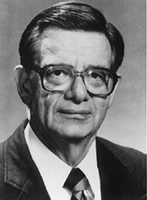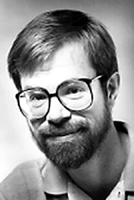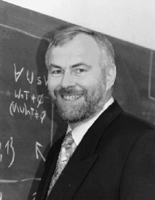NAE Elects New Members
May 22, 1999

Donald W. Peaceman
A professor of mathematics and computer science at Berkeley, Demmel is a leader in the field of high-performance numerical computing and algorithms for linear algebra. "In a world where exponential growth of computing speed almost seems to defy the laws of gravity," says Alan Edelman of MIT and Berkeley, "these algorithms play an increasingly critical role for scientists and engineers who are replacing physical models and laboratories with numerical computations." Through his influence on the LAPACK project, Demmel has made new high-accuracy algorithms for singular value and eigenvalue computations widely available. Although "unique in his ability to create the mathematical foundations for algorithms," Edelman says, "he is not content with theory alone---he makes sure the mathematics reaches countless users of library software through the famous LAPACK project. This is how mathematics achieves real impact."

James W. Demmel
"Jim Demmel is the leading computer scientist working on high-performance numerical linear algebra algorithms and software---the cornerstones of scientific computing and of computational science and engineering," says Margaret Wright of Bell Laboratories, Lucent Technologies. "He has a remarkable combination of algorithmic insights, originality of thought, mathematical rigor, and willingness to write broadly useful software of the highest standard."
As a speaker and expositor, Wright says, he "takes it as a personal mission to explain---clearly, carefully, and rigorously---important and often misunderstood aspects of numerical linear algebra." Demmel is the author of several SIAM books: most recently Applied Numerical Linear Algebra (1997) and the ScaLAPACK Users' Guide (with Blackford et al., 1997), in addition to the LAPACK Users' Guide (second edition, with Anderson et al., 1995) and Templates for the Solution of Linear Systems: Building Blocks for Iterative Methods (with Barrett et al., 1993). Readers will have the chance to judge the quality of his talks for themselves at the 1999 SIAM Annual Meeting in Atlanta, where he is scheduled to give an invited talk, "Numerical Linear Algebra: Performance, Accuracy and Ease-of-Use."
Demmel has received numerous prizes for his research, including the J.H. Wilkinson Prize in Numerical Analysis and Scientific Computing (from SIAM in 1993), the Fox Prize in Numerical Analysis in 1986, and the Householder Thesis Prize in 1984. In 1988 he received the SIAM Activity Group on Linear Algebra Prize; in 1991, after trying in vain to avoid awarding its prize to the same person twice, SIAG/LA conceded that it would be unconscionable to award it to anyone else and once again named him the recipient (with William Kahan this time).
Donald Peaceman, a Houston-based consultant, was honored for his contributions to the development and use of transient three-dimensional multiphase simulators for predicting the performance of petroleum reservoirs. One of the "fathers of modern reservoir simulation," Peaceman "is truly an engineer," says Mary Wheeler of the University of Texas, Austin. Peaceman well models are well known in the industry, Wheeler tells SIAM News; most of the simulators used today incorporate numerical algorithms and well models he developed.
Along with his well models, Peaceman is most well known as the inventor, with Henry Rachford, of alternating-direction implicit (ADI) methods for the solution of differential equations. It was the challenge of developing accurate models of oil reservoirs in the face of severe computational constraints, Paul Davis wrote in SIAM News (July 1993), that "led to the development of ADI methods and their extensions, tools that carried reservoir modeling to the threshold of the 1970s." Peaceman and Rachford's now-famous paper, "The Numerical Solution of Parabolic and Elliptic Differential Equations" (Journal of the Society for Industrial and Applied Mathematics), was cited often enough when it appeared in 1955 to elicit queries from the Science Citation Index, Wheeler says.
Extensions of the ideas in that paper, work done by Peaceman with Rachford and Jim Douglas, Jr., "have been applied in settings far removed from the petroleum industry," Davis wrote in SIAM News. In scientific computing, for example, "ADI is the first widely known example of operator splitting. . . . ADI remains the most popular finite difference technique among chemical engineers for modeling tubular fixed-bed catalytic reactors, and it is common in many other computational models."
Peaceman joined the Humble Oil & Refining Company (now Exxon Production Research Company) in 1951 and remained there until his retirement in 1986. Over the years he has worked effectively with applied mathematicians, including Wheeler, to further the understanding of flows in porous media and has been very supportive of students in the field and university programs, especially those at Rice University, where he is currently an adjunct professor.
Martin Gr�tschel, who has been vice president of the Konrad Zuse Zentrum for Information Technology in Berlin since 1991 (see article in SIAM News, March 1999), was named a foreign associate of NAE for his contributions to optimization and its applications.

Martin Gr�tschel
Gr�tschel, who heads the discrete mathematics branch at ZIB, "has been an intellectual leader in the field of integer programming and combinatorial optimization, contributing simultaneously to both underlying theory and to computations and practical applications," says Thomas L. Magnanti, dean of the School of Engineering and Institute Professor at MIT. "He has been a pioneer in the field of computational polyhedral combinatorics---the construction of good models and allied computational methods for solving discrete optimization problems. His work has inspired a generation of other researchers to further pursue this approach to problem solving."
"He has developed much of the underlying theory," Magnanti adds, "and he has made important contributions to many applications, including the design of telecommunication networks, VLSI chips, and mass transit systems, as well as production control and the control of industrial robots."
Gr�tschel is a "talented mathematician," says Robert Bixby, of Rice University, but "even more important are the drive and enormous amounts of energy he brings to every project" he undertakes. Not only has he has made important theoretical contributions, using combinatoric optimization methods, Bixby concludes, he has produced a wide range of practical applications to real engineering problems.

